Ponce (LPD-15)
1971–2017
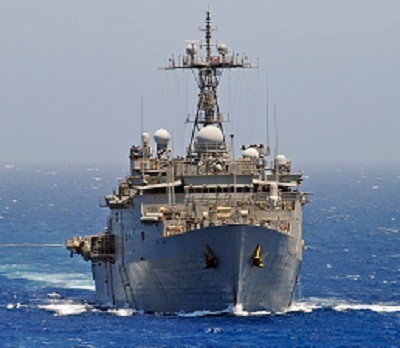
A city in the Commonwealth of Puerto Rico, named after the Spanish explorer Juan Ponce de Leon, the European discoverer of Florida, and the first governor of Puerto Rico.
(LPD-15: displacement 16,914; length 569'; beam 105'; draft 22'; speed 20 knots; complement 420; capacity 917; armament 8 3-inch; class Austin)
Ponce (LPD-15) was laid down on 31 October 1966 at Seattle, Wash., by Lockheed Shipbuilding and Construction Co.; launched on 20 May 1970; sponsored by Mrs. John J. Hyland Jr.; and commissioned on 10 July 1971, Capt. George W. Farris in command.
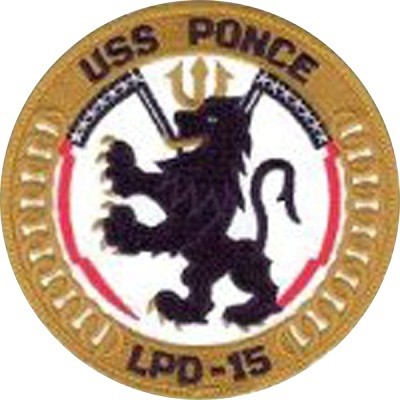
The ship’s insignia consists of four major elements: a rampant lion signifying the high spiritedness of the Navy-Marine Corps team that serves in her; a trident, emblematic of U.S. naval power and supremacy; an anchor chain, linking the ship’s name and her designator symbols; and the total purple lion, which is the coat of arms of Juan Ponce de Leon, a continuing reminder of the ship’s bond with the people of her namesake city.
Ponce reported that her mission was to provide “combat integrity of assault forces during extended deployments by combining troop carrying capability, floodable well deck, landing craft capability and helicopter operating deck.”
Ponce set out for her first deployment in January 1973, during a voyage to the Mediterranean, where she operated as part of Amphibious Squadron 2 with the Sixth Fleet. On 30 April 1980, President James E. Carter Jr., ordered the Navy to divert ships scheduled for exercise Solid Shield 80 in the Atlantic and Caribbean to assist the Coast Guard in rescuing Cuban refugees who fled that country en masse in dangerously overcrowded boats through the Florida Straits for the U.S. Ponce charted a course for those waters in June and during three weeks of patrols rescued 640 people. Additional vessels involved included amphibious assault ship Saipan (LHA-2) and amphibious transport dock Shreveport (LPD-12), along with a combination of amphibious ships and minesweepers that supported the Coast Guard, and in addition, Lockheed P-3C Orions flew patrols primarily from Naval Air Station Key West, Fla. Eleven Navy ships ultimately took part. On 8 July the Navy terminated its support of the boat lift. More than 125,000 Cuban refugees fled to the U.S. by 12 June, when the tempo of Solid Shield 80 diminished. Ponce received the Humanitarian Service Medal for her part in rescuing the migrants.
Ponce collided with dock landing ship Fort Snelling (LSD-30) during a towing exercise while en route to Portsmouth, England, on 2 February 1982. The impact caused minor damage to Ponce’s port side, mainly to the accommodation ladder and flight deck catwalk. Following her British visit, the ship completed her scheduled exercises with marines in Norwegian waters.
The ship lost her stern gate during heavy seas while she attempted to move an assault craft to Radio Island, near Morehead City, N.C., on 14 February 1984. Ponce received the stern gate from command ship Coronado (AGF-11) while completing repairs at Philadelphia Naval Shipyard, Pa.
Ponce steamed off the Lebanese coast (April–August 1984) during that country’s civil war and supported the United States Embassy in Beirut and the marines deployed ashore for security. The ship subsequently received the Meritorious Unit Citation for her actions during the crisis.
Ponce took part with amphibious assault ship Saipan (LHA-2), tank landing ship Sumter (LST-1181), and destroyer Peterson (DD-969) in Operation Sharp Edge, the evacuation of people caught in the civil war in Liberia, on 5 August 1990. Ponce inserted a reinforced marine rifle company from the 22nd Marine Expeditionary Unit (MEU) into the United States Embassy compound in Monrovia for increased security. She transported 1,111 of the 1,648 people evacuated during the initial phase of the operation (through 19 August) to Freetown, Sierra Leone. The opposing Liberian factions subsequently on 28 November signed a cease-fire, and two days later the evacuations ended, following the American evacuation of a total of 2,609 people including 330 U.S. citizens. Sharp Edge concluded on 9 January 1991.
Late the following year, the ship assisted victims of Hurricane Andrew in Florida (29 August–18 September 1992), and then conducted counter-narcotics operations in the Caribbean (7–10 and 13–15 October, and 17 October–2 November).
International diplomatic efforts to counter what Serbian President Slobodan Milosevic termed “cleansing” of ethnic Albanians from Kosovo collapsed, and on 24 March 1999, NATO began Operation Allied Force — an air campaign to reduce the Serbs’ ability to sustain their operations. In addition, on 11 April Sikorsky MH-53E Sea Dragons of Helicopter Mine Countermeasures Squadrons (HMs) 14 and 15, embarked on board mine countermeasures ship Inchon (MCS-12), delivered 6,000 pounds of relief supplies to refugees in Kukes, Albania. These flights began the Navy’s contribution to NATO Operation Shining Hope — humanitarian assistance to people displaced by the fighting in Kosovo. Ponce took part at times in both Allied Force and Shining Hope. A 7.4-magnitude earthquake devastated Turkey on 17 August, killing more than 24,000 people. Amphibious assault ship Kearsarge (LHD-3) steamed across the Mediterranean in response to the crisis (19–23 August) and her embarked helos ferried aid to the victims through 12 September. Ponce joined her during the disaster and also helped victims.
Ponce deployed to the Mediterranean again and while passing through the Strait of Messina on 29 August 2001, discovered two derelict Italian boats floating with the current. The ship sent a detachment that boarded the boats, and, upon learning that they were unmanned, she carried them in her well deck to Catania, Sicily, where the Americans turned them over to Italian Coast Guardsmen of their Corps of the Port Captaincies — Coast Guard.
The ship transported marines from Camp Lejeune, N.C., as part of Amphibious Task Force East during Operation Iraqi Freedom I (11 January–30 June 2003). At the end of February she became the flagship of Mine Countermeasures Squadron 3, designated as Commander, Task Group 55.4. The group at times included Gunston Hall (LSD-44), coastal minehunters Cardinal (MHC-60) and Raven (MHC-61), Ardent (MCM-12) and Dextrous (MCM-13), a special clearance team, two explosive ordnance disposal (EOD) units, a detachment of HM-14’s Sea Dragons deployed to Manama, Bahrain, a British detachment, and an Australian detachment. Ponce directed the effort to clear mines that blocked the Khawr Abd Allah estuary and the port of Umm Qasr. Allied EOD divers worked with marine mammals and unmanned underwater vehicles to search for the elusive but deadly devices, and Sea Dragons towed magnetic minesweeping sleds that cleared a 200 yard wide channel (5–28 March). The group’s operations enabled ships to being to deliver humanitarian aid to the victims of the war, and they continued to widen the channel during the succeeding weeks.
Ponce deployed with the Kearsarge Expeditionary Strike Group to the Mediterranean and Arabian Gulf on 25 March 2005, and in mid-August took part in the two-week exercise Infinite Moonlight with the Jordanians. Kearsarge and Ashland (LSD-48) visited Aqaba, Jordan, but on 19 August Islamist jihadists of the Abdullah Azzam Brigades (linked with al-Qaeda) fired three Katyusha-type rockets at the ships. The rockets missed the vessels but killed a Jordanian sentry and wounded another when a weapon soared over the bow of Ashland and hit a warehouse. Kearsarge and Ashland stood out of the harbor and operated in the area until the 25th. Ponce steamed in the Gulf of Aqaba at the time of the attack, and rendezvoused with her consorts and supported them during the tense time.
Heavy rains began on 28 July 2010 and continued into the first week of August that caused widespread flooding in Pakistan, and killed an estimated 1,600 people and rendered hundreds of thousands homeless. On 9 August Peleliu (LHA-5), Pearl Harbor (LSD-52), and Dubuque (LPD-8) arrived off Karachi, Pakistan. At times 15 Boeing Vertol CH-46E Sea Knights of Marine Medium Helicopter Squadron (HMM) 165 and CH-53E Super Stallions of Marine Heavy Helicopter Squadron (HMH) 465 from the 15th MEU, augmented by MH-60S Seahawks of Helicopter Sea Combat Squadron (HSC) 23 and three MH-53E Sea Dragons of HM-15 Detachment 2, helped evacuate 10,051 people and deliver 1,895,038 pounds of relief supplies to victims. Some of these helos operated from Pakistani airfields at Chaklala, Ghazi, and Pano Aqil. Two Aérospatiale SA-330J Pumas also flew from MSC-manned auxiliary dry cargo ship Lewis and Clark (T-AKE-1). Meanwhile, McDonnell Douglas AV-8B Harrier IIs of VMA-311 carried out close air support missions from Peleliu for coalition troops fighting Islamic extremists in Afghanistan. On 16 September Kearsarge, Carter Hall (LSD-50), and Ponce, with Bell Boeing MV-22B Ospreys of Marine Medium Tiltrotor Squadron (VMM) 266 and helos of the 26th MEU embarked, reached the area. Air Force cargo aircraft, ten Army Boeing CH-47 Chinooks, and eight UH-60 Black Hawks also flew humanitarian assistance missions. Peleliu came about on 31 October. Harry S. Truman (CVN-75) subsequently arrived, and on 15 November four Super Stallions of the 26th MEU refueled on board the carrier.
On 31 March 2012, Ponce was reclassified as an Afloat Forward Staging Base, Interim [AFSB(I)], for MH-53E Sea Dragon mine countermeasures helicopters. In addition, Ponce would support operations of patrol and small mine-clearance vessels. The ship deployed from Naval Station Norfolk, Va., with what she reported as a USN and MSC “hybrid” crew on 1 June, and spent the next five years forward deployed to the Fifth Fleet as a “proof-of-concept” for such a ship. Sailors and civilian specialists carried out a variety of exercises and tests exploring new concepts and equipment on board the ship during her forward deployment. The ship participated in exercises with coalition partners including Alligator Dagger and Artemis Trident, embarked crisis response elements, and carried out visit, board, search, and seizure operations, focused collection patrols, and pattern of life analyses.
One of these programs consisted of the Laser Weapon System (LaWS), which, on 8 April 2013, the Navy announced would be installed on board Ponce for an at-sea demonstration the following year. The Naval Sea Systems Command built the technology demonstrator from commercial fiber solid state lasers, utilizing combination methods developed at the Naval Research Laboratory (ONR). Temporarily installed in guided missile destroyer Dewey (DDG-105), the LaWS could be directed onto targets from a radar track obtained from a Mk 15 Phalanx Close-In Weapon System (CIWS) or another targeting source. That capability provided Navy ships a method for sailors to defeat small boat threats and aerial targets without using bullets.
Ponce received and mounted the LaWS and carried out a series of system tests with ONR, the Naval Sea Systems Command, Naval Research Laboratory, Naval Surface Warfare Center Dahlgren Division, and industry partners in the Arabian Gulf (September–November 2014). Despite heavy weather that included at times high winds and heat and humidity extremes, the laser system hit a target fitted on board a small boat closing Ponce at high speed, shot a Boeing Insitu ScanEagle unmanned aircraft system out of the sky, and destroyed other moving targets at sea. “We ran this particular weapon, a prototype, thorough some extremely tough paces,” Rear Adm. Matthew L. Klunder, Chief of Naval Research, summarized, “and it locked on and destroyed the targets we designated with near-instantaneous lethality.” Evaluators used the data collected during the tests to guide their development of weapons under ONR’s Solid-State Laser-Technology Maturation program.

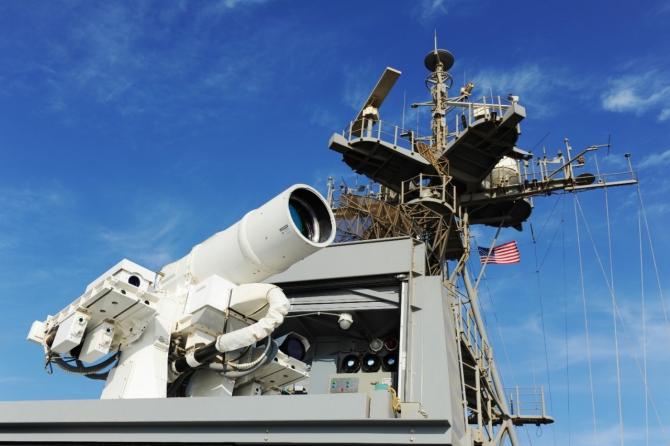
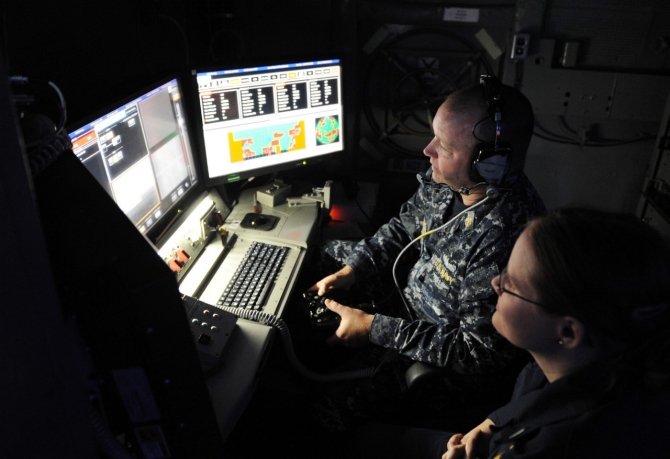
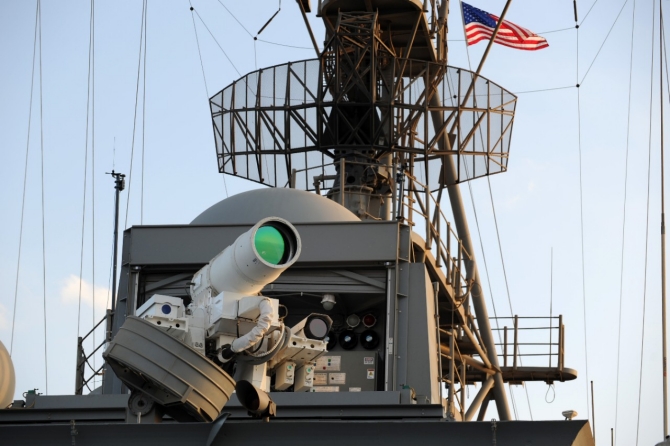
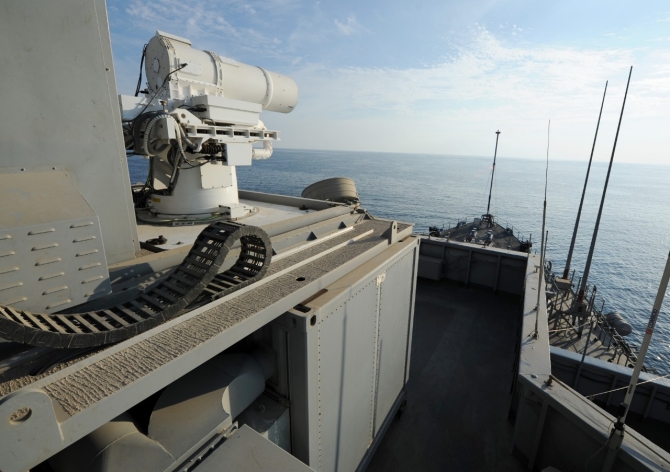
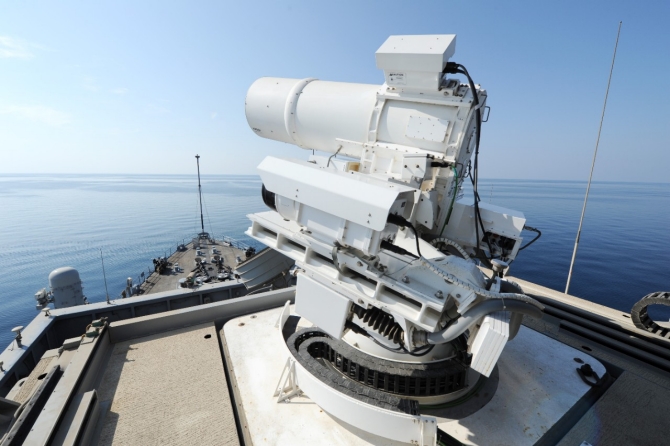
Islamist forces within Yemen, likely Houthi rebels, fired one or more shoulder-fired rockets or antiship cruise missiles at Swift (T-HSV-2), a hybrid catamaran formerly operated by the Military Sealift Command (MSC) but leased to the United Arab Emirates, while she carried humanitarian aid for people in the region through the Bab-el-Mandeb, on 1 October 2016. The U.S. subsequently deployed Mason (DDG-87), Nitze (DDG-94), and Ponce to the trouble-torn area to ensure that ships could continue to transit the strategically vital waterway. The rebels unsuccessfully attacked Mason and Ponce as they steamed in international waters in the Bab-el-Mandeb on 9 October and again three days later. The U.S. retaliated against three of the rebel-controlled radar sites in Yemen on 12 October, and Pentagon Press Secretary Peter Cook described the battle:
“Early this morning local time, the U.S. military struck three radar sites in Houthi-controlled territory on Yemen’s Red Sea coast. Initial assessments show the sites were destroyed. The strikes -- authorized by President Obama at the recommendation of Secretary of Defense Ash Carter and Chairman of the Joint Chiefs General Joseph Dunford -- targeted radar sites involved in the recent missile launches threatening USS Mason and other vessels operating in international waters in the Red Sea and the Bab al-Mandeb. These limited self-defense strikes were conducted to protect our personnel, our ships and our freedom of navigation in this important maritime passageway. The United States will respond to any further threat to our ships and commercial traffic, as appropriate, and will continue to maintain our freedom of navigation in the Red Sea, the Bab al-Mandeb and elsewhere around the world.”
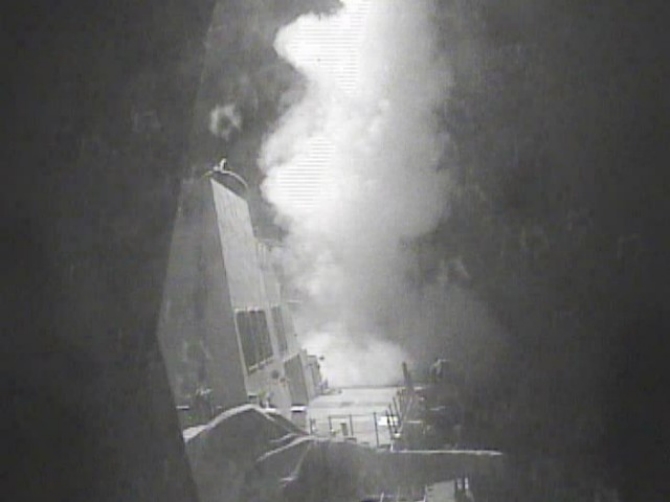
Following the commissioning ceremony for Zumwalt (DDG-1000) on 15 October at Baltimore, Md., Adm. John M. Richardson, Chief of Naval Operations, revealed to the press that the Houthi rebels unsuccessfully attacked Mason a third time:
“The latest is there has been recent activity today with the Mason once again. It appears to have come under attack in the Red Sea again from coastal defense cruise missiles fired from the coast of Yemen,” he said. “So as you know this is the third such attack. We suffered one about a week ago. We also saw one in the middle of last week and now we see more activity.”
Ponce ended her nearly five-year deployment as an afloat forward staging base to the Arabian Gulf when she came about, passed through the Mediterranean, crossed the Atlantic, and returned to the United States (18 August–27 September 2017), where she offloaded her ordnance at Naval Weapons Station Yorktown, Va., and then moored at Norfolk. The Navy then began preparations to retire Ponce after she had served the fleet for more than four decades.
Ponce was decommissioned on 14 October 2017 at Pier 2 Naval Station Norfolk. Rear Adm. Jesse A. Wilson, Commander, Naval Surface Force Atlantic, served as the guest speaker during the ceremony, which the ship reported offered plank owners and former crewmen the opportunity to walk the vessel for the last time and proved an “outstanding success.” Civilian mariners of the MSC then steamed the ship to the Ship Maintenance Facility at Philadelphia,
Detailed history pending.
Mark L. Evans
15 November 2017


